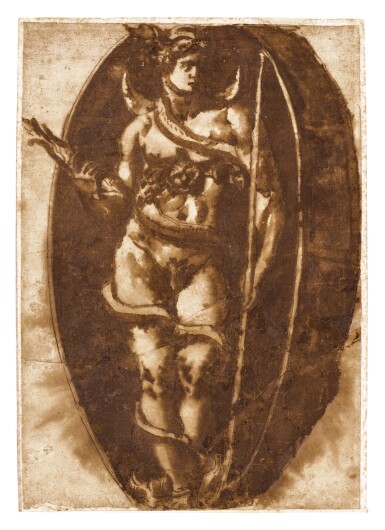Master Works on Paper from Five Centuries
Master Works on Paper from Five Centuries

Attributed to Benvenuto Cellini
Project for a seal of the Accademia del Disegno, Florence
Live auction begins on:
February 5, 04:00 PM GMT
Estimate
30,000 - 40,000 USD
Lot Details
Description
Attributed to Benvenuto Cellini
(Florence 1500 - 1571)
Project for a seal of the Accademia del Disegno, Florence
Pen and brown ink and wash over black chalk;
bears old attribution on the backing, verso: Polidoro da Caravaggio / 1495-1543
278 by 190 mm; 11 by 7 ½ in.
Francesco Maria Niccolo Gabburri (1676-1742), Florence;
Marchese Francesco Tortora Brayda di Belvedere (until 1990);
sale, Monaco, Christie’s, 7 December 1990, lot 202A (as Benvenuto Cellini);
sale, Venice, San Marco, Casa d'Asta, 9 July 2006;
with Stanley Moss (1925-2024), New York;
Private collection, New York
P. Calamandrei, Scritti e inediti celliniani, Florence 1971 (Sigillo e caratteri della scuola del Disegno fatti da Benvenuto Cellini);
B. Cellini, Discorso sopra l’arte del Disegno, in P. Barocchi, 1979;
G.C. Sciolla, “Schizzi, macchie e pensieri”: il disegno negli scritti d’arte dal Rinascimento al Romanticismo, in “Il Disegno, forme, tecniche, significati”, Milan 1992, p. 16;
M. Scalini, Benvenuto Cellini, Florence, 1995, p. 80, pl. 93;
D. Pegazzano, Benvenuto Cellini, Rome, 2005, p. 180
This study relates to the design for the seal of the Accademia del Disegno (the Florentine Academy), officially founded by Duke Cosimo de' Medici in 1562; the real creator, and most active promoter, of this immensely important institution was, however, the painter and biographer Giorgio Vasari (1511-1574). Michelangelo (1475-1564) and Duke Cosimo I (1519-1574) were together proclaimed the first heads of this august establishment. Thirty-six artist members were elected, and amateurs and theoreticians were also eligible for membership.
A competition for the design of the Accademia's official seal was also announced by Vasari. Not counting the present sheet, there are six known studies related to this commission by the great goldsmith and sculptor Benvenuto Cellini: one was formerly in the Archivio Calamandrei, Florence,1 and the others are in the Louvre,2 the British Museum,3 the Graphische Sammlung, Munich (two drawings)4 and in a private collection. All these drawings have traditionally been dated between 1563 and 1569. As Marco Simone Bolzoni has observed, the study in a private collection, representing the ancient Greek god of creation, Phanes, seems to be the prototype for the present sheet.5 In fact, although the latter now depicts Apollo, it bears the same sign of the zodiac in the surrounding oval, and may also originally have represented Phanes.6
As Nicholas Turner has suggested, it is possible that the design that was finally submitted to the Florentine Academy was the one now in the British Museum, which is extensively inscribed in Cellini’s hand.7 This represents a classical personification of nature, within a lozenge: a winged female figure, flanked, at her feet, by a lion (the emblem of Florence) and a serpent (the emblem of Duke Cosimo).8
The version of the design with Apollo at its center, to which the present sheet relates, is generally considered the first, discarded, idea for the academy seal. A drawing by Cellini in the Graphische Sammlung in Munich (inv. 2247) shows Apollo, the god of light, armed with a bow and arrow. He stands triumphantly over the serpent Python, symbolizing the victory of Disegno over Ignorance. The drawing is inscribed: Apollo e sol la Luce/Cosmo e principio a la gran scuola, e Duce.
1 Piero Calamandrei, Il sigillo di Benvenuto e altri scritti celliniani, Rome 2021, pp. IX-XIV, 81-104
2 Paris, Musée du Louvre, inv. 2752
3 London, British Museum, inv. 1860,0616.18
4 Munich, Staatliche Graphische Sammlung, inv. nos. 2247, 2264
5 e-mail dated 27 November 2024
6 A primordial god of creation, fertility and light, born from a cosmic egg at the beginning of creation
7 Nicholas Turner, Florentine Drawings of the sixteenth century, London 1986, p. 163, no. 118, reproduced in color p. 164
